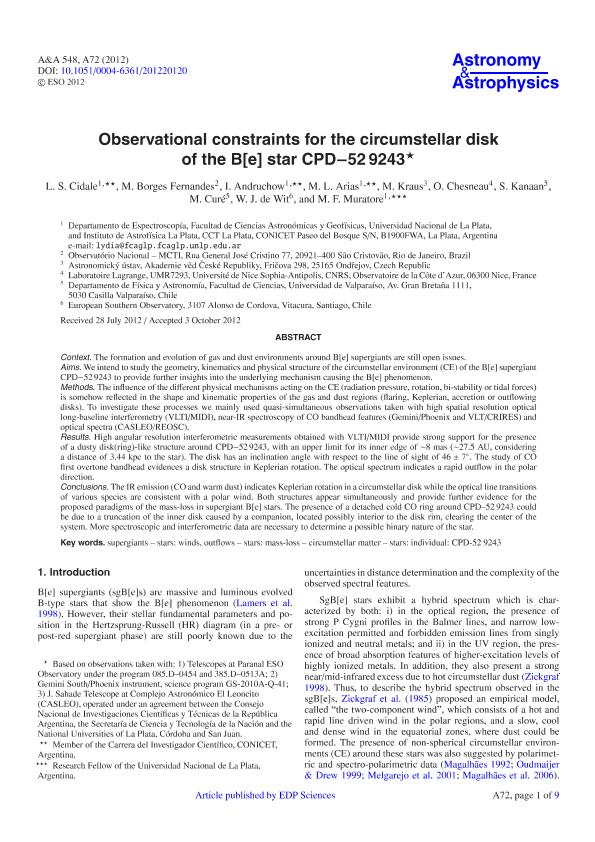Artículo
Observational constraints for the circumstellar disk of the B[e] star CPD-52 9243
Cidale, Lydia Sonia ; Borges Fernandes, M.; Andruchow, Ileana
; Borges Fernandes, M.; Andruchow, Ileana ; Arias, María Laura
; Arias, María Laura ; Kraus, M.; Chesneau, O.; Kanaan, S.; Cure, M.; de Wit, W. J.; Muratore, M. F.
; Kraus, M.; Chesneau, O.; Kanaan, S.; Cure, M.; de Wit, W. J.; Muratore, M. F.
 ; Borges Fernandes, M.; Andruchow, Ileana
; Borges Fernandes, M.; Andruchow, Ileana ; Arias, María Laura
; Arias, María Laura ; Kraus, M.; Chesneau, O.; Kanaan, S.; Cure, M.; de Wit, W. J.; Muratore, M. F.
; Kraus, M.; Chesneau, O.; Kanaan, S.; Cure, M.; de Wit, W. J.; Muratore, M. F.
Fecha de publicación:
10/2012
Editorial:
Edp Sciences
Revista:
Astronomy And Astrophysics
ISSN:
0004-6361
Idioma:
Inglés
Tipo de recurso:
Artículo publicado
Clasificación temática:
Resumen
Context. The formation and evolution of gas and dust environments around B[e] supergiants are still open issues.
Aims. We intend to study the geometry, kinematics and physical structure of the circumstellar environment (CE) of the B[e] supergiant CPD−52 9243 to provide further insights into the underlying mechanism causing the B[e] phenomenon.
Methods. The influence of the different physical mechanisms acting on the CE (radiation pressure, rotation, bi-stability or tidal forces) is somehow reflected in the shape and kinematic properties of the gas and dust regions (flaring, Keplerian, accretion or outflowing disks). To investigate these processes we mainly used quasi-simultaneous observations taken with high spatial resolution optical long-baseline interferometry (VLTI/MIDI), near-IR spectroscopy of CO bandhead features (Gemini/Phoenix and VLT/CRIRES) and optical spectra (CASLEO/REOSC).
Results. High angular resolution interferometric measurements obtained with VLTI/MIDI provide strong support for the presence of a dusty disk(ring)-like structure around CPD−52 9243, with an upper limit for its inner edge of ~8 mas (~27.5 AU, considering a distance of 3.44 kpc to the star). The disk has an inclination angle with respect to the line of sight of 46 ± 7°. The study of CO first overtone bandhead evidences a disk structure in Keplerian rotation. The optical spectrum indicates a rapid outflow in the polar direction.
Conclusions. The IR emission (CO and warm dust) indicates Keplerian rotation in a circumstellar disk while the optical line transitions of various species are consistent with a polar wind. Both structures appear simultaneously and provide further evidence for the proposed paradigms of the mass-loss in supergiant B[e] stars. The presence of a detached cold CO ring around CPD–52 9243 could be due to a truncation of the inner disk caused by a companion, located possibly interior to the disk rim, clearing the center of the system. More spectroscopic and interferometric data are necessary to determine a possible binary nature of the star.
Palabras clave:
Supergiants
,
Circumstellar Matter
,
Winds
Archivos asociados
Licencia
Identificadores
Colecciones
Articulos(IALP)
Articulos de INST.DE ASTROFISICA LA PLATA
Articulos de INST.DE ASTROFISICA LA PLATA
Citación
Cidale, Lydia Sonia; Borges Fernandes, M.; Andruchow, Ileana; Arias, María Laura; Kraus, M.; et al.; Observational constraints for the circumstellar disk of the B[e] star CPD-52 9243; Edp Sciences; Astronomy And Astrophysics; 548; A72; 10-2012; 1-9
Compartir
Altmétricas



